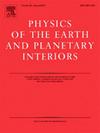The sensitivity of lowermost mantle anisotropy to past mantle convection
IF 2.4
3区 地球科学
Q2 GEOCHEMISTRY & GEOPHYSICS
引用次数: 0
Abstract
It is widely believed that seismic anisotropy in the lowermost mantle is caused by the flow-induced alignment of anisotropic crystals such as post-perovskite. What is unclear, however, is whether the anisotropy observations in the lowermost mantle hold information about past mantle flow, or if they only inform us about the present-day flow field. To investigate this, we compare the general and seismic anisotropy calculated using Earth-like mantle convection models where one has a time-varying flow, and another where the present-day flow is constant throughout time. To do this, we track a post-perovskite polycrystal through the flow fields and calculate texture development using the sampled strain rate and the visco-plastic self-consistent approach. We assume dominant slip on (001) and test the effect of the relative importance of this glide plane over others by using three different plasticity models with different efficiencies at developing texture. We compare the radial anisotropy parameters and the anisotropic components of the elastic tensors produced by the flow field test cases at the same location. We find, under all ease-of-texturing cases, the radial anisotropy is very similar (difference ) in the majority of locations and in some regions, the difference can be very large (). The same is true when comparing the elastic tensors directly. Varying the ease-of-texture development in the crystal aggregate suggests that easier-to-texture material may hold a stronger signal from past flow than harder-to-texture material. Our results imply that broad-scale observations of seismic anisotropy such as those from seismic tomography, 1-D estimates and normal mode observations, will be mainly sensitive to present-day flow. Shear-wave splitting measurements, however, could hold information about past mantle flow. In general, mantle memory expressed in anisotropy may be dependent on path length in the post-perovskite stability field. Our work implies that, as knowledge of the exact causative mechanism of lowermost mantle anisotropy develops, we may be able to constrain both present-day and past mantle convection.

最下地幔各向异性对过去地幔对流的敏感性
人们普遍认为,最下地幔的地震各向异性是由流动引起的各向异性晶体(如后辉石)排列造成的。然而,目前尚不清楚的是,在最下地幔中观测到的各向异性是否包含了有关过去地幔流动的信息,或者说,它们是否只为我们提供了有关现今流动场的信息。为了研究这个问题,我们比较了使用类地幔对流模型计算出的一般各向异性和地震各向异性,其中一个模型的流动是随时间变化的,而另一个模型的现今流动在整个时间内是恒定的。为此,我们在流场中跟踪了后透辉石多晶体,并使用采样应变率和粘弹性自洽方法计算了纹理的发展。我们假定 (001) 上存在主要滑移,并使用三种不同的塑性模型来测试该滑移面相对于其他滑移面的相对重要性,这些模型在纹理发展方面具有不同的效率。我们比较了径向各向异性参数和同一位置流场测试案例产生的弹性张量的各向异性分量。我们发现,在所有易于形成纹理的情况下,大多数位置的径向各向异性非常相似(差异为 2%),而在某些区域,差异可能非常大(10%)。直接比较弹性张量也是如此。晶体集合体中纹理发展的难易程度不同,表明纹理较易发展的物质可能比纹理较难发展的物质从过去的流动中获得更强的信号。我们的结果表明,对地震各向异性的大尺度观测,如地震层析成像、一维估算和法模观测,将主要对现今的流动敏感。然而,剪切波分裂测量可能包含有关过去地幔流动的信息。一般来说,以各向异性表示的地幔记忆可能取决于后围岩稳定场的路径长度。我们的工作意味着,随着对最下层地幔各向异性确切成因机制的了解,我们可能能够对现今和过去的地幔对流进行约束。
本文章由计算机程序翻译,如有差异,请以英文原文为准。
求助全文
约1分钟内获得全文
求助全文
来源期刊

Physics of the Earth and Planetary Interiors
地学天文-地球化学与地球物理
CiteScore
5.00
自引率
4.30%
发文量
78
审稿时长
18.5 weeks
期刊介绍:
Launched in 1968 to fill the need for an international journal in the field of planetary physics, geodesy and geophysics, Physics of the Earth and Planetary Interiors has now grown to become important reading matter for all geophysicists. It is the only journal to be entirely devoted to the physical and chemical processes of planetary interiors.
Original research papers, review articles, short communications and book reviews are all published on a regular basis; and from time to time special issues of the journal are devoted to the publication of the proceedings of symposia and congresses which the editors feel will be of particular interest to the reader.
 求助内容:
求助内容: 应助结果提醒方式:
应助结果提醒方式:


